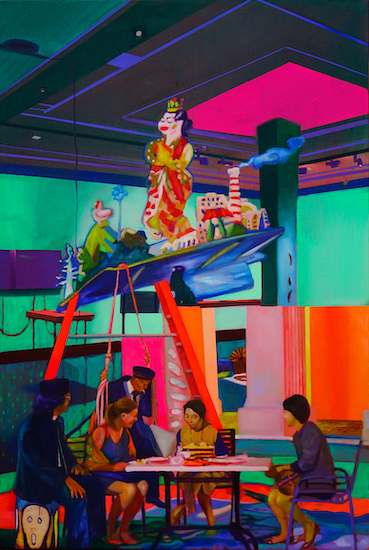Yavuz Gallery is proud to present Indonesian-artist Zico Albaiquni in Is this parochial or international? Does it really matter?. The exhibition is a two-part presentation; the first taking place in Singapore, and the latter in Albaiquni’s home country of Indonesia in March 2022.
Is this parochial or international? Does it really matter? features a new suite of paintings in the artist’s signature vibrant and multicoloured style that taps into art history and the congruence between translating local truths and Western-held ideals.
Albaiquni’s works serve as an index to investigate discourses on museological culture, exhibition-making, and decolonisation in the Indonesian art history canon. Highlighting its wide-ranging implications and deep entanglements on global narratives, the artist charts the development of Indonesia alongside its influence on expansionist policies and creations of stereotypes of the colonised.
True to his artistic engagement and practice, Albaiquni weaves specific iconographies and slivers of critical thinking from a wide array of seminal artists – contemporaries and luminaries alike including: the 1980s “Gerakan Seni Rupa Baru” (New Art Movement); performance artist Fajar Abadi, fervent humanitarian activist and artist Semsar Siahaan; archival photographs by Ohannes Kurkdjia; and museum dioramas and exhibition settings. Is this parochial or international? Does it really matter? casts an expansive query onto exoticism, global art ideals and cultural omission.
These notions are accentuated in the piece Tales from Bad New Days, where Albaiquni poses an opening question to the audience through its visceral composition. Taking cues from one of Marcel Duchamp’s last major works, the Étant donnés and its depiction of the nearly naked bodies of controversial performance artist Vanessa Beecroft’s Le Membre Fantôme, he draws parallels to liberating the constraints of perspective, the corrupt gaze, and the trappings of classism throughout the history of artmaking.
In Don’t Touch The (Modern) Art, Albaiquni introspects the titular term – a word of caution one often hears when visiting exhibitions. He alludes this phrase to a litany, a talisman of sorts that conserves the purity of an object similar to consecration. The artist depicts this condition in the foreground of the painting where Semsar Siahaan intentionally burns a sculpture by his mentor and artist Sunaryo, after it was shown in the 1981 Fine Arts Triennial in India. Siahaan then defended his radical actions with claims to support traditional art methods which he thought was highly exploited by albeist artists. Albaiquni considers the romance of the “burning act” being the final stage of the ritual in completing Sunaryo’s work, noting that the ancient practice of fire ritual for healing and purification originates from Hindu culture.
In this oeuvre, Albaiquni charts an arc that looks beyond diversifying canons, curricula, and practitioners. It recognises that we now study, teach, and display art with culturally specific methods that oftentimes get lost in translation when the past, present and future collide.



